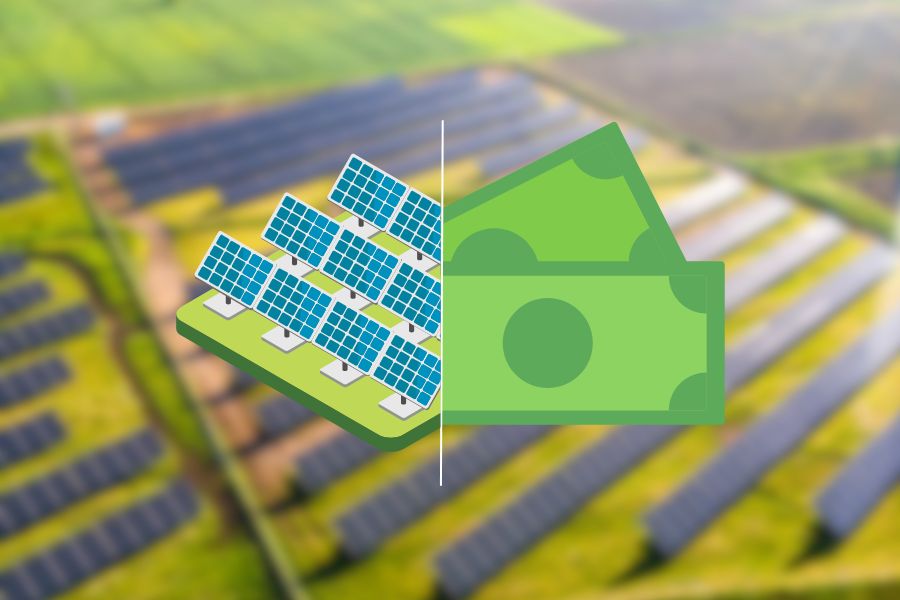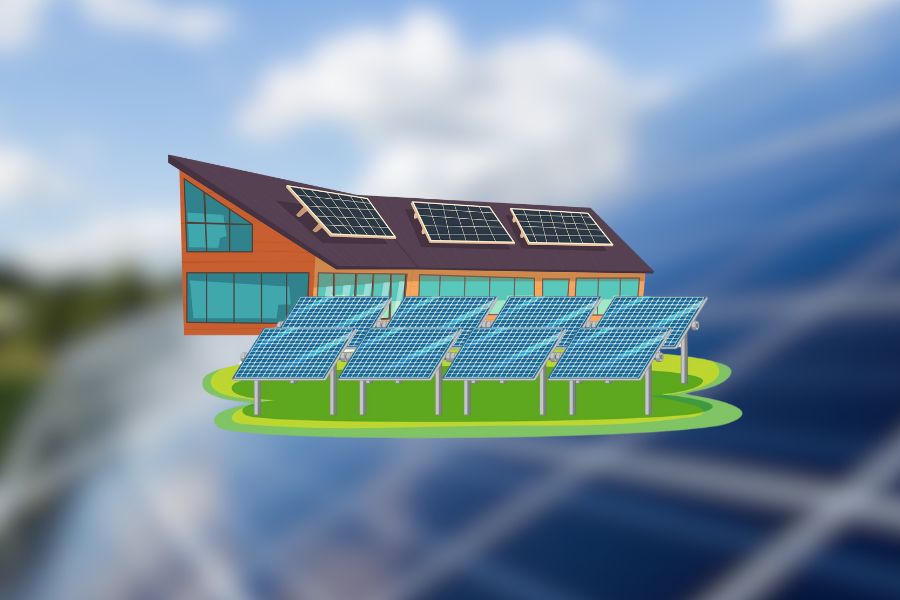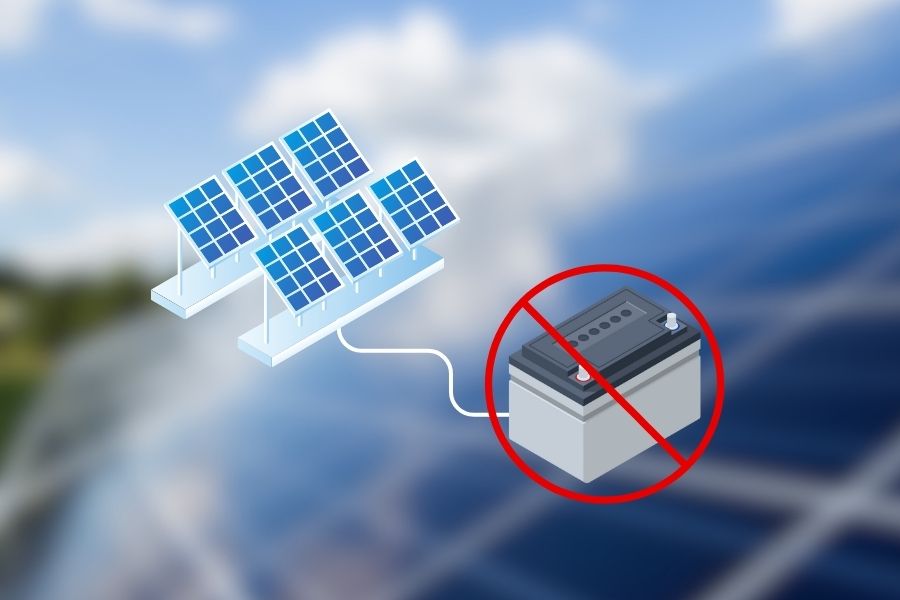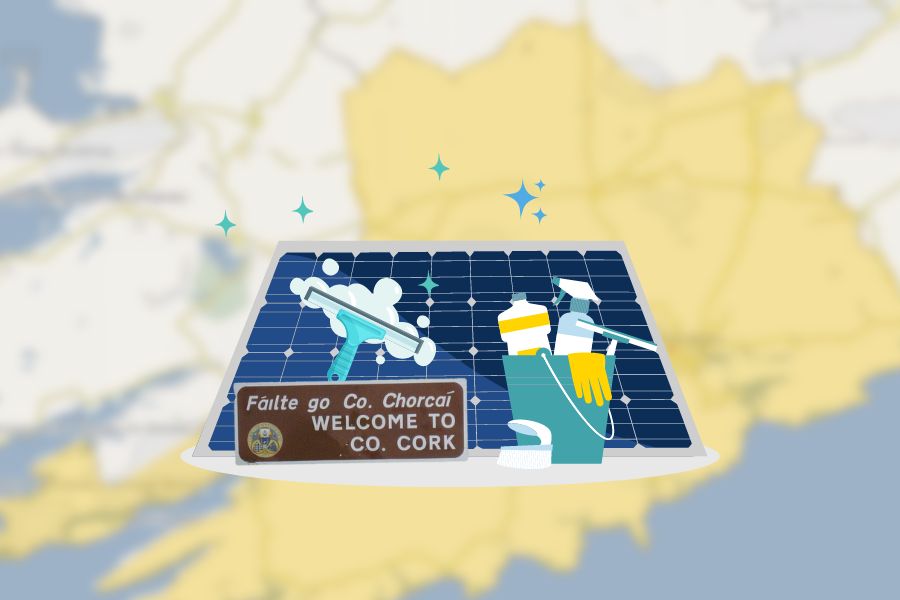The optimal period to charge your electric vehicle (EV) with solar panels is during peak sunlight hours. It harnesses the maximum solar output during these hours, ensuring efficient energy utilization and reducing grid dependence.
You can maximize your renewable energy source by aligning your EV’s charging routine with the sun’s peak performance.
This synergy not only optimizes power consumption but also maximizes your solar investment.
The Basics of Grid-Tied Solar Systems
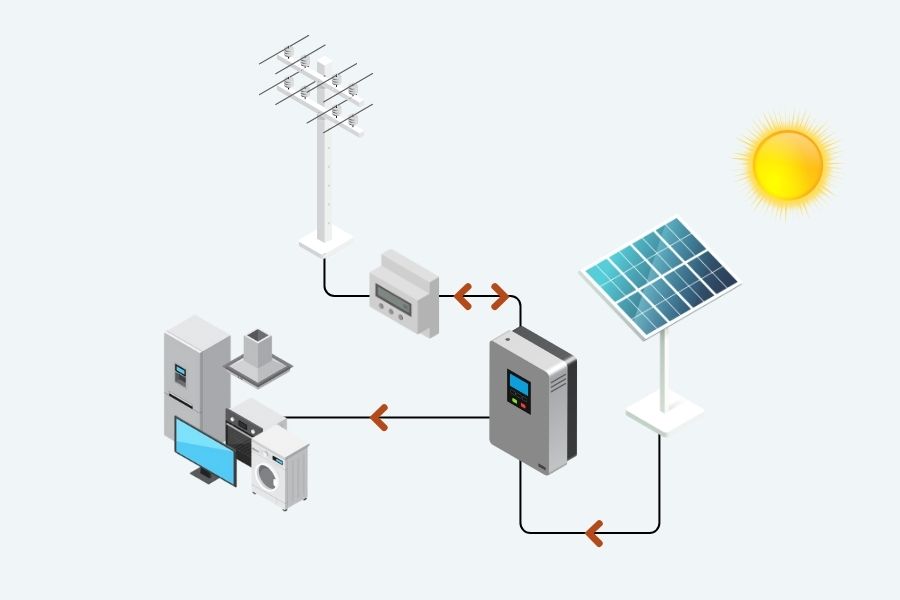
A grid-tied solar system is a solar power solution connected directly to the local utility grid. Here’s why that’s noteworthy:
When your solar panels produce more power than your home or business needs, excess energy can be fed back into the grid.
Conversely, when your panels aren’t producing enough (like during nighttime or cloudy days), you can draw power from the grid to meet your needs.
Key Components
- Solar Panels: These are the heart of any solar PV system. Made up of photovoltaic cells, they convert sunlight directly into electricity.
- Inverters: Solar panels produce direct current (DC) electricity. But most homes and businesses use alternating current (AC) power. That’s where inverters come in – they convert that DC power from your panels into usable AC power for your home and the grid.
- Mounting Equipment: This helps secure the solar panel systems on your roof or the ground. Proper mounting ensures your panels are angled to capture maximum sunlight.
- Monitoring Systems: Many modern grid-tied systems include software or apps that allow you to monitor your system’s performance and electricity production in real-time.
- Electrical Safety Gear: This includes disconnects, breakers, and other gear to ensure safety for you and the utility workers.
Advantages
- Financial Incentives: Many areas offer incentives, rebates, or credits to homeowners who install grid-tied systems. A popular one is net metering, where homeowners are credited for the excess power they contribute to the grid.
- No Batteries Needed: Since you’re connected to the grid, you don’t need expensive battery systems to store power. However, if you decide to add a battery in the future for backup power, that’s an option!
- Reduced Energy Costs: Over time, you can enjoy savings that offset and surpass the initial investment, making the system cost-effective in the long run.
Considerations
- Dependence on the Grid: If there’s a power outage, grid-tied systems without batteries typically shut down. This is a safety measure to protect utility workers from electricity being fed into the grid while they might be working on it.
- Installation and Upfront Costs: Even with falling prices, the initial investment can be considerable. However, many find that the long-term benefits outweigh these costs.
How to Safely Disconnect Solar Panels
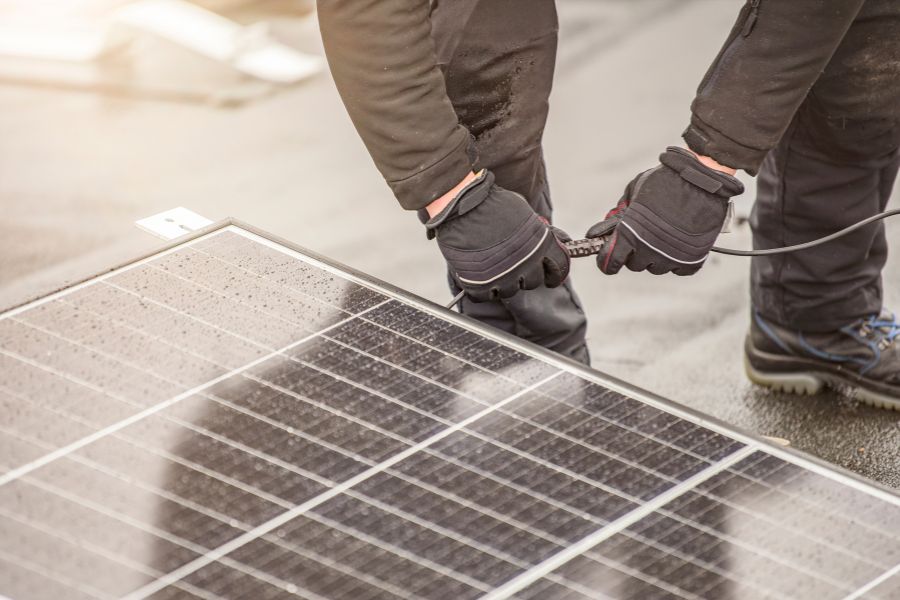
Turn Off the Solar System
First, switch off the solar inverter. Most inverters have both an AC and DC isolator – turn both to the “OFF” position.
Wait for the inverter to power down completely, which can be confirmed by checking its display or indicator lights.
Turn Off the Main Breaker
Go to your main electrical panel and turn off the main circuit breaker. This disconnects your house or facility from the grid and ensures that no external sources of power flow into your solar system.
Disconnect the Solar Panel Strings
If your setup has a combiner box that combines the output of multiple strings of solar panels – you will need to open it.
Each solar panel string will have a breaker or disconnect switch inside the combiner box. Turn each of these to the “OFF” position.
Physically Disconnect the Panels
Only after ensuring no current is flowing through the solar power system, begin disconnecting the physical connections of the solar panels.
Start by unplugging the connectors that link each panel to its adjoining panel. These connectors usually require pressing or pulling a locking mechanism to release them.
If your panels are hardwired (less common), you’ll need a suitable tool like a screwdriver to disconnect the wires.
Grounding Considerations
When working with the solar panel system, it’s important to ensure you’re not creating a path for the current to flow. Wearing rubber gloves and rubber-soled shoes is a good practice.
If you’re disconnecting the panels for a long time, consider connecting their terminals to the ground. This helps prevent any potential build-up of electrical charge.
Storing the Panels
If you remove the panels for storage, ensure they’re kept in a dry and safe place, away from potential damage. Cover them to prevent dust and debris accumulation.
Reconnecting the System
If you intend to reconnect the panels, follow the process in reverse. Begin by physically connecting the panels, turning on the string breakers in the combiner box, turning on the main breaker, and turning on the inverter.
Safety Precautions
- Always use insulated tools to avoid accidental electrical contact.
- Avoid working under wet conditions, as water is a good conductor of electricity and can lead to accidental shocks.
- Never touch exposed wires or terminals. Even if the portable solar system is turned off, residual currents might exist.
- Wear appropriate safety gear, including safety glasses, gloves, and rubber-soled shoes.
What Benefits Do Grid-Tied and Off-Grid Have Respectively?
Grid-Tied Solar Systems (Often Referred to as Hybrid Solar Systems)
- Net Metering with the Utility Company: Homeowners can sell excess electricity back to the power company. This leads to credits or reductions in electricity bills. Overproduction during sunny periods can offset costs when the solar panel is disconnected.
- Reliability during Power Outages: If there’s an issue with the solar panels or during low solar production, the grid, managed by the utility company, ensures a consistent power supply.
- Lower Initial Costs: Answering the question of “How many solar panels do I need?” becomes easier with grid-tied systems, as they’re generally less expensive initially since they might not require a solar battery or additional off-grid system equipment.
- Scalability: Grid-tied or hybrid solar systems can be expanded with ease. Homeowners can start small and increase the number of solar panels based on their evolving needs.
- Less Maintenance: The absence of batteries in many grid-tied systems means less upkeep, especially when considering issues like a solar panel disconnected from the system.
- Environmental Benefits: Hybrid solar systems reduce dependence on fossil fuels by producing green energy, even when connected to the utility company’s grid.
Off-Grid Solar Systems
- Energy Independence: Off-grid systems, utilizing a solar battery, provide a complete break from the local utility company. As a result, you’re in control of your power without any external dependencies.
- Ideal for Remote Locations: For places where connecting to the grid is challenging or expensive, an off-grid system, despite the question of “how many solar panels are required?” becomes a prime electricity solution.
- No Grid Vulnerabilities: No worries about power outages from the main power company. Off-grid means immunity from grid-associated blackouts or brownouts.
- Battery Storage: Using a solar battery, off-grid systems store surplus electricity produced during sunlit hours for usage during the night or when solar production is low.
- No Unexpected Disconnections: With an off-grid system, there’s no risk of the solar panel getting disconnected from the main grid. This ensures consistent power.
- Long-Term Cost Savings: The initial investment might be substantial. Still, considering the rising costs of grid electricity and the independence from the utility company, off-grid living can be economically beneficial in the long run.
What Are AC and DC Disconnects and Why Are They Important?
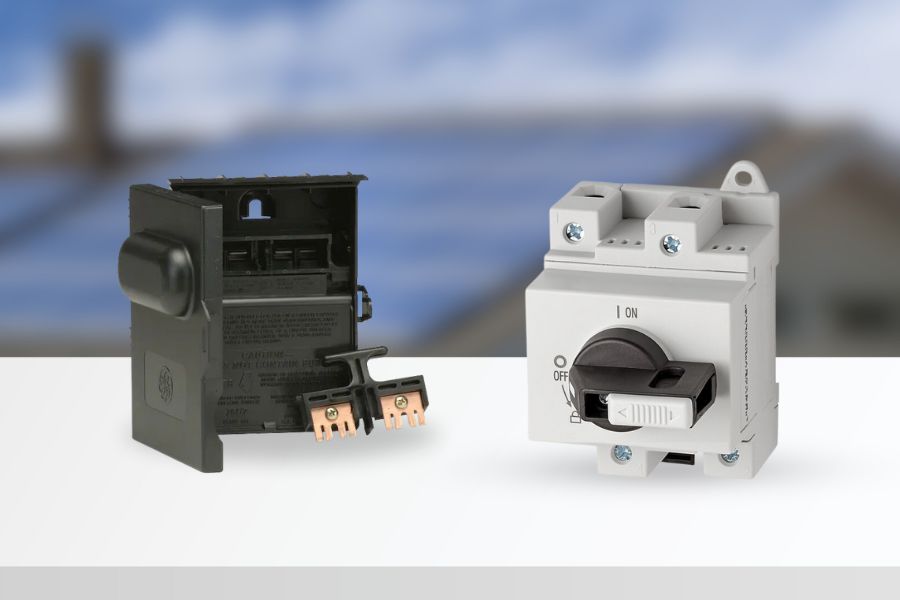
AC Disconnect
An AC disconnect is a switch that breaks the connection of an AC circuit. In solar panel installations, it’s typically used to disconnect the inverter (which converts DC from the panels into AC for home use) from the AC grid.
Importance
- Safety: It provides a way to disconnect the solar system from the grid safely, ensuring that workers or technicians can perform maintenance or repairs.
- Protection: During electrical faults or surges from the grid, disconnecting can prevent potential damage to the solar equipment.
- Regulation: In many regions, having an easily accessible AC disconnect is a regulatory requirement for grid-tied solar systems.
DC Disconnect
A DC disconnect is a switch that breaks a DC circuit. In the context of solar systems, it’s used to disconnect the solar panels from the inverter.
Importance
- Safety: It allows for a safe way to cut off the DC power coming from the PV system, which is vital during maintenance, troubleshooting, or emergencies. Since sunlight can continuously generate DC power, breaking the circuit is crucial.
- Protection: In the event of faults or issues with the inverter, the DC disconnect can protect the solar panels by isolating them from the rest of the system.
- Efficiency: If the inverter has issues and needs to be serviced or replaced, the DC disconnect allows the rest of the system to remain intact. Therefore, it speeds up the repair process.
Why Are They Important?
- Safety: Both AC and DC disconnects are primary safety devices. They ensure that power can be safely cut off, preventing electric shocks or equipment damage during maintenance, emergencies, or system faults.
- System Longevity: By isolating parts of a system during faults or surges, disconnects can prevent damage, prolonging the lifespan of the equipment.
- Regulatory Compliance: Many electrical and safety codes require the presence of accessible disconnects in solar and electrical installations.
Frequently Asked Questions
How Do I Know if My System Is Connected to the Grid?
You can check a few indicators to determine whether your system is connected to the grid. First, look at your inverter display or monitoring system.
If it displays power output values and you can see electricity being fed into the grid or your home drawing power from the grid, your system is likely connected.
Also, most grid-tied systems have bi-directional meters showing power consumed from and fed back to the grid.
If your meter displays this information, it indicates a grid connection. Lastly, if you’re receiving electricity bills with net metering credits, it’s another confirmation that you’re grid-tied.
Reasons for Disconnecting Solar Panels From the Grid
- Maintenance and Repairs: Sometimes, for the safety of workers, it’s necessary to disconnect solar panels from the grid during maintenance or repairs.
- Blackouts: In some grid-tied systems without battery backup, solar panels may automatically disconnect during a grid blackout to ensure the safety of repair crews working on the grid.
- System Upgrades: A temporary disconnection may be needed if you add more panels or update system components.
- Safety Concerns: Electrical issues, fire hazards, or faulty equipment might necessitate a system disconnection until problems are resolved.
- Regulatory or Utility Policies: Some local utilities may require periodic disconnections or checks to ensure system compliance with evolving grid codes.
Do Solar Panels Need a Disconnect Breaker?
Yes, solar panels generally need a disconnect breaker. It serves several vital roles:
- Safety: The disconnect breaker allows homeowners and emergency personnel to safely disconnect the solar panels from the grid, especially during emergencies or maintenance.
- Regulatory Compliance: Many local electrical codes and utility companies require a visible and accessible disconnect breaker for grid-tied solar systems.
- System Management: A disconnect breaker can be useful if you need to shut down the system for troubleshooting or adjustments.
Can Solar Panels Be Removed and Reinstalled?
Absolutely. You can remove solar panels and then reinstall them, whether because of roof repairs, relocating to a new home, or other reasons.
However, you must carefully ensure that the panels, mounts, and associated wiring are removed and reinstalled correctly and safely.
We recommend engaging professionals to manage the removal and reinstallation to guarantee the system’s integrity and functionality.
Can I Install Solar and Not Connect to the Grid?
Yes, you can. Such systems are known as off-grid solar systems. They operate independently from the grid and often come with battery storage to store excess energy produced during the day, used at night, or during periods of low solar production.
Off-grid systems are popular in remote locations without easy grid access, but they can also be used by those who simply prefer complete energy independence.
However, note that off-grid systems typically require a more significant upfront investment due to the need for storage solutions and may require more regular maintenance.
Conclusion
Understanding how to disconnect your solar panels from the grid is essential for every solar system owner.
Whether it’s for maintenance, safety, or regulatory compliance, there will likely come a time when you’ll need to perform this task.
While the specifics can vary based on your system and local regulations, it typically involves a disconnect breaker or switch.
Always prioritize safety and, if uncertain, consult with professionals or your utility company. Being prepared ensures the longevity of your solar investment and maintains the seamless integration of renewable energy into our daily lives.

